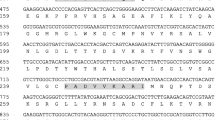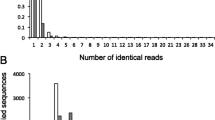Abstract
The aim of this work is to underline the biological significance of mitochondrial uncoupling proteins (UCPs) in ectothermic fish using the gilthead sea bream (Sparus aurata L.) as an experimental model. A contig of 1,990 bp in length was recognized as a UCP1 ortholog after initial searches in the gilthead sea bream AQUAFIRST database (http://www.sigenae.org/aquafirst). Additional searches were performed in skeletal muscle by RT-PCR, and the amplified PCR product was recognized as UCP3 after sequence completion by 5′- and 3′RACE. UCP1 expression was mostly detected in liver, whereas UCP3 transcripts were only found in skeletal and cardiac muscle fibres (white skeletal muscle > red skeletal muscle > heart). Specific gene regulation of UCP1 (liver) and UCP3 (white skeletal muscle) was addressed in physiological models of age, seasonal growth and energy-metabolic unbalances. Both the increase in energy demand (stress confinement) and the reduction in energy supply during adaptive cold response in winter down-regulated UCP1 expression. Conversely, transcript levels of UCP3 were higher with age, seasonal fattening and dietary deficiencies in essential fatty acids leading to the increase in fatty acid flux towards the muscle. This close association between UCP1 and UCP3 with the oxidative and metabolic tissue status is perhaps directly related to the ancestral protein UCP function, and allows the use of UCPs as lipotoxicity markers in ectothermic fish.






Similar content being viewed by others
References
Abe T, Mujahid A, Sato K, Akiba Y, Toyomizu M (2006) Possible role of avian uncoupling protein in down-regulating mitochondrial superoxide production in skeletal muscle of fasted chickens. FEBS Lett 580:4815–4822
Benedito-Palos L, Saera-Vila A, Calduch-Giner JA, Kaushik S, Pérez-Sánchez J (2007) Combined replacement of fish meal and oil in practical diets for fast growing juveniles of gilthead sea bream (Sparus aurata L.): networking of systemic and local components of GH/IGF axis. Aquaculture 267:199–212
Benedito-Palos L, Navarro JC, Sitjà-Bobadilla A, Bell JG, Kaushik S, Pérez-Sánchez J (2008) High levels of vegetable oils in plant protein-rich diets fed to gilthead sea bream (Sparus aurata L.): growth performance, muscle fatty acid profiles and histological alterations of target tissues. Br J Nutr 100:992–1003
Bermejo-Nogales A, Benedito-Palos L, Saera-Vila A, Calduch-Giner JA, Sitjà-Bobadilla A, Pérez-Sánchez J (2007) Confinement exposure induces glucose regulated protein 75 (GRP75/mortalin/mtHsp70/PBP74/HSPA9B) in the hepatic tissue of gilthead sea bream (Sparus aurata L.). Comp Biochem Physiol 149B:428–438
Björnsson BT, Johansson V, Benedet S, Einarsdottir IE, Hildahl J, Agustsson T, Jönsson E (2002) Growth hormone endocrinology of salmonids: regulatory mechanisms and mode of action. Fish Physiol Biochem 27:227–242
Boss O, Samec S, Paoloni-Giacobino A, Rossier C, Dulloo A, Seydoux J, Muzzin P, Giacobino JP (1997) Uncoupling protein-3: a new member of the mitochondrial carrier family with tissue-specific expression. FEBS Lett 408:39–42
Calduch-Giner JA, Mingarro M, Vega-Rubín de Celis S, Boujard D, Pérez-Sánchez J (2003) Molecular cloning and characterization of gilthead sea bream, (Sparus aurata) growth hormone receptor (GHR). Assessment of alternative splicing. Comp Biochem Physiol 136B:1–13
Choi CS, Fillmore JJ, Kim JK, Liu ZX, Kim S, Collier EF, Kulkarni A, Distefano A, Hwang YJ, Kahn M, Chen Y, Yu CL, Moore IK, Reznick RM, Higashimori T, Shulman GI (2007) Overexpression of uncoupling protein 3 in skeletal muscle protects against fat-induced insulin resistance. J Clin Invest 117:1995–2003
Clapham JC, Arch JRS, Chapman H, Haynes A, Lister C, Moore GBT, Piercy V, Carter SA, Lehner I, Smith SA, Beeley LJ, Godden RJ, Herrity N, Skehel M, Changani KK, Hockings PD, Reid DG, Squires SM, Hatcher J, Trail B, Latcham J, Rastan S, Harper AJ, Cadenas S, Buckingham JA, Brand MD, Abuin A (2000) Mice overexpressing human uncoupling protein-3 in skeletal muscle are hyperphagic and lean. Nature 406:415–418
Emre Y, Hurtaud C, Ricquier D, Bouillaud F, Hughes J, Criscuolo F (2007) Avian UCP: the killjoy in the evolution of the mitochondrial uncoupling proteins. J Mol Evol 65:392–402
Evans ZP, Ellett JD, Schmidt MG, Schnellmann RG, Chavin KD (2008) Mitochondrial uncoupling protein-2 mediates steatotic liver injury following ischemia/reperfusion. J Biol Chem 283:8573–8579
Gates AC, Bernal-Mizrachi C, Chinault SL, Feng C, Schneider JG, Coleman T, Malone JP, Townsend RR, Chakravarthy MV, Semenkovich CF (2007) Respiratory uncoupling in skeletal muscle delays death and diminishes age-related disease. Cell Metab 6:497–505
Gonzalez-Barroso MD, Ricquier D, Cassard-Doulcier AM (2000) The human uncoupling protein-1 gene (UCP1): present status and perspectives in obesity research. Obes Rev 1:61–72
Harper JA, Stuart JA, Jekabsons MB, Roussel D, Brindle KM, Dickinson K, Jones RB, Brand MD (2002) Artifactual uncoupling by uncoupling protein 3 in yeast mitochondria at the concentrations found in mouse and rat skeletal-muscle mitochondria. Biochem J 361:49–56
Heaton GM, Wagenvoord RJ, Kemp A, Nicholls DG (1978) Brown adipose tissue mitochondria: photoaffinity labelling of the regulatory site of energy dissipation. Eur J Biochem 82:515–521
Hesselink MKC, Keizer HA, Borghouts LB, Schaart G, Kornips CFP, Slieker LJ, Sloop KW, Saris WHM, Schrauwen P (2001) Protein expression of UCP3 differs between human type 1, type 2a, and type 2b fibers. FASEB J 15:1071–1073
Hoeks J, Hesselink MKC, van Bilsen M, Schaart G, van der Vusse GJ, Saris WHM, Schrauwen P (2003) Differential response of UCP3 to medium versus long chain triacylglycerols; manifestation of a functional adaptation. FEBS Lett 555:631–637
Horvath T, Diano S, Miyamoto S, Barry S, Gatti S, Alberati D, Livak F, Lombardi A, Moreno M, Goglia F, Mor G, Hamilton J, Kachinskas D, Horwitz B, Warden CH (2003) Uncoupling proteins-2 and 3 influence obesity and inflammation in transgenic mice. Int J Obes 27:433–442
Hughes J, Criscuolo F (2008) Evolutionary history of the UCP gene family: gene duplication and selection. BMC Evol Biol 8:306
Hughes DA, Jastroch M, Stoneking M, Klingenspor M (2009) Molecular evolution of UCP1 and the evolution history of mammalian non-shivering thermogenesis. BMC Evol Biol 9:4
Jastroch M, Wuertz S, Kloas W, Klingenspor M (2005) Uncoupling protein 1 in fish uncovers an ancient evolutionary history of mammalian nonshivering thermogenesis. Physiol Genomics 22:150–156
Jastroch M, Buckingham JA, Helwig M, Klingenspor M, Brand MD (2007) Functional characterisation of UCP1 in the common carp: uncoupling activity in liver mitochondria and cold-induced expression in the brain. J Comp Physiol 177B:743–752
Jastroch M, Withers KW, Taudien S, Frappell PB, Helwig M, Fromme T, Hirschberg V, Heldmaier G, McAllan BM, Firth BT, Burmester T, Platzer M, Klingenspor M (2008) Marsupial uncoupling protein 1 sheds light on the evolution of mammalian nonshivering thermogenesis. Physiol Genomics 32:161–169
Jiang N, Zhang G, Bo H, Qu J, Ma G, Cao D, Wen L, Liu S, Ji LL, Zhang Y (2009) Upregulation of uncoupling protein-3 in skeletal muscle during exercise: a potential antioxidant function. Free Radic Biol Med 46:138–145
Kontani Y, Wang Y, Kimura K, Inokuma KI, Saito M, Suzuki-Miura T, Wang Z, Sato Y, Mori N, Yamashita H (2005) UCP1 deficiency increases susceptibility to diet-induced obesity with age. Aging Cell 4:147–155
Kozak LP, Koza RA (1999) Mitochondrial uncoupling proteins and obesity: molecular and genetic aspects of UCP1. Int J Obes 23:S33–S37
Kratky D, Strauss JG, Zechner R (2001) Tissue-specific activity of lipoprotein lipase in skeletal muscle regulates the expression of uncoupling protein 3 in transgenic mouse models. Biochem J 355:647–652
Krauss S, Zhang CY, Lowell BB (2005) The mitochondrial uncoupling-protein homologues. Nat Rev Mol Cell Biol 6:248–261
Liang XF, Ogata HY, Oku H, Chen J, Hwang F (2003) Abundant and constant expression of uncoupling protein 2 in the liver of red sea bream Pagrus major. Comp Biochem Physiol 136A:655–661
Livak KJ, Schmittgen TD (2001) Analysis of relative gene expression data using real-time quantitative PCR and the 2−ΔΔCT method. Methods 25:402–408
Locke RM, Rial E, Nicholls DG (1982) The acute regulation of mitochondrial proton conductance in cells and mitochondria from the brown fat of cold-adapted and warm-adapted guinea pigs. Eur J Biochem 129:381–387
Lynn SG, Powell KA, Westneats DF, Shepherd BS (2009) Seasonal and sex-specific mRNA levels of key endocrine genes in adult yellow perch (Perca flavescens) from Lake Erie. Mar Biotechnol 11:210–222
Mark FC, Lucassen M, Pörtner HO (2006) Thermal sensitivity of uncoupling protein expression in polar and temperate fish. Comp Biochem Physiol 1D:365–374
Mingarro M, Vega-Rubín de Celis R, Astola A, Pendón C, Valdivia MM, Pérez-Sánchez J (2002) Endocrine mediators of seasonal growth in gilthead sea bream (Sparus aurata): the growth hormone and somatolactin paradigm. Gen Comp Endocrinol 128:102–111
Modrianský M, Murdza-Inglis DL, Patel HV, Freeman KB, Garlid KD (1997) Identification by site-directed mutagenesis of three arginines in uncoupling protein that are essential for nucleotide binding and inhibition. J Biol Chem 272:24759–24762
Nabben M, Hoeks J (2008) Mitochondrial uncoupling protein 3 and its role in cardiac- and skeletal muscle metabolism. Physiol Behav 94:259–269
Nabben M, Hoeks J, Briedé JJ, Glatz JFC, Moonen-Kornips E, Hesselink MKC, Schrauwen P (2008) The effect of UCP3 overexpression on mitochondrial ROS production in skeletal muscle of young versus aged mice. FEBS Lett 582:4147–4152
Nicholls DG, Locke RM (1984) Thermogenic mechanisms in brown fat. Physiol Rev 64:1–64
Parker N, Crichton PG, Vidal-Puig AJ, Brand MD (2009) Uncoupling protein-1 (UCP1) contributes to the basal proton conductance of brown adipose tissue mitochondria. J Bioenerg Biomembr 41:335–342
Pecqueur C, Cassard-Doulcier AM, Raimbault S, Miroux B, Fleury C, Gelly C, Bouillaud F, Ricquier D (1999) Functional organization of the human uncoupling protein-2 gene, and juxtaposition to the uncoupling protein-3 gene. Biochem Biophys Res Commun 255:40–46
Pecqueur C, Alves-Guerra MC, Gelly C, Lévi-Meyrueis C, Couplan E, Collins S, Ricquier D, Bouillaud F, Miroux B (2001) Uncoupling protein 2, in vivo distribution, induction upon oxidative stress, and evidence for translational regulation. J Biol Chem 276:8705–8712
Pérez-Sánchez J, Calduch-Giner JA, Mingarro M, Vega-Rubín de Celis S, Gómez-Requeni P, Saera-Vila A, Astola A, Valdivia MM (2002) Overview of fish growth hormone family. New insights in genomic organization and heterogeneity of growth hormone receptors. Fish Physiol Biochem 27:243–258
Peterson JM, Bryner RW, Frisbee JC, Alway SE (2008) Effects of exercise and obesity on UCP3 content in rat hindlimb muscles. Med Sci Sports Exerc 40:1616–1622
Raimbault S, Dridi S, Denjean F, Lachuer J, Couplan E, Bouillaud F, Bordas A, Duchamp C, Taouis M, Ricquier D (2001) An uncoupling protein homologue putatively involved in facultative muscle thermogenesis in birds. Biochem J 353:441–444
Rial E, Poustie A, Nicholls DG (1983) Brown adipose tissue mitochondria: regulation of the 32000-Mr uncoupling protein by fatty acids and purine nucleotides. Eur J Biochem 137:197–203
Saera-Vila A, Calduch-Giner JA, Navarro I, Pérez-Sánchez J (2007) Tumour necrosis factor (TNF)α as a regulator of fat tissue mass in the Mediterranean gilthead sea bream (Sparus aurata L.). Comp Biochem Physiol 146B:338–345
Samec S, Seydoux J, Russell AP, Montani JP, Dulloo AG (2002) Skeletal muscle heterogeneity in fasting-induced upregulation of genes encoding UCP2, UCP3, PPARγ and key enzymes of lipid oxidation. Pflugers Arch 445:80–86
Solanes G, Vidal-Puig A, Grujic D, Flier JS, Lowell BB (1997) The human uncoupling protein-3 gene. Genomic structure, chromosomal localization, and genetic basis for short and long form transcripts. J Biol Chem 272:25433–25436
Stuart JA, Harper KM, Brindle KM, Brand MD (1999) Uncoupling protein 2 from carp and zebrafish, ectothermic vertebrates. Biochim Biophys Acta 1413:50–54
Vidal-Puig A, Solanes G, Grujic D, Flier JS, Lowell BB (1997) UCP3: an uncoupling protein homologue expressed preferentially and abundantly in skeletal muscle and brown adipose tissue. Biochem Biophys Res Commun 235:79–82
Acknowledgments
The authors are grateful to E. Rial and anonymous reviewers for helpful suggestions and revision of the manuscript and M.A. González for excellent technical assistance in PCR assays. This work was partially funded by the European Union (FOOD-CT-2006-16249: Sustainable Aquafeeds to Maximise the Health Benefits of Farmed Fish for Consumers, AQUAMAX) and Spanish (Ingenio-2010 Programme; Improvement of Aquaculture Production by the use of biotechnological tools, AQUAGENOMICS) projects. AB-N was recipient of a PhD fellowship from CSIC-BANCAJA.
Author information
Authors and Affiliations
Corresponding author
Additional information
Communicated by G. Heldmaier.
Rights and permissions
About this article
Cite this article
Bermejo-Nogales, A., Calduch-Giner, J.A. & Pérez-Sánchez, J. Gene expression survey of mitochondrial uncoupling proteins (UCP1/UCP3) in gilthead sea bream (Sparus aurata L.). J Comp Physiol B 180, 685–694 (2010). https://doi.org/10.1007/s00360-009-0441-6
Received:
Revised:
Accepted:
Published:
Issue Date:
DOI: https://doi.org/10.1007/s00360-009-0441-6




